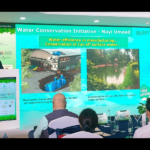Experts Warn Of Challenges In Heavy Commercial EV Adoption Despite Rapid Growth

Although battery costs are decreasing, experts emphasise that the successful execution of government-backed schemes and efficient fund deployment are crucial for further adoption
Norway became the first country where electric vehicles (EVs) surpassed gas-powered vehicles. India also strives to follow the same path concerning the inclusion of EVs. In 2023, the country sold 1.53 million EVs, which was a 50 per cent increase from 2022. The share of EVs in India’s auto sales increased from 1.75 per cent in 2021 to 6.38 per cent in 2023.
Indian Union Minister of Road Transport and Highways of India, Nitin Gadkari said, “EVs to have cost parity with petrol and diesel cars in the next two years, EV manufacturers don’t need any subsidy now and India will be in the position to export lithium-ion batteries to different parts of the world.”
Gadkari also reiterated that he wants to eliminate diesel and petrol vehicles from India in the next ten years. India has the potential to export electric two-wheelers and EV sales likely to reach ten million annually by 2030 while creating 50 million jobs.
“Our biggest import continues to be crude oil, and India is the third most polluted country. Hence, the business case for transport electrification is clearly established. The government has been very supportive and the state government has been rolling out the red carpet for the EV ecosystem. The target is 30 per cent EV by 2030, so the growth potential is huge. Cost of batteries is coming down, however, the execution of government-backed schemes and efficiency of fund deployment is crucial for further inclusion,” said Prashant Tiwari, Chief Sustainability Officer, Amara Raja Group.
Under the EV ecosystem, it is still about cell manufacturing, the real value lies in converting lithium into lithium carbonate. These are certain challenges which are going to come up, as a country we will resolve those challenges and become a big net exporter of EVs, added Tiwari.
Government support for transport electrification further pushed the EV inclusion. Various schemes such as faster adoption and manufacturing of (hybrid) and electric vehicles in India (FAME India) scheme in 2015, production linked incentive (PLI) scheme for manufacturing advanced chemistry cells (ACC) in 2021 and reducing the GST on EVs from 12 per cent to 5 per cent and the GST on charging stations from 18 per cent per cent to 5 per cent provided strong support for their further expansion.
“It is very difficult to teach Delhites to use public transport, however convincing them to adopt EVs is more convenient. A lot needs to be done for creating charging infrastructure accessible and available, vehicles themselves need to be cheaper. The transition will accelerate and EV inclusion is going to increase to adapt to the current environment,” said K N Sreekumar, Vice President and Head of Sustainability, Digitalisation, Smart Infrastructure, Siemens.
Struggle With Heavy Commercial Vehicles
Alok Verma, Head Corporate Strategy and ESG, Ashok Leyland emphasised, “There will be rapid adoption with exponential growth for EV space. However, the challenge lies in the adoption of heavy transport and it will be sluggish. Even Europe is struggling on the front and Bloomberg also forecasted that intermediate commercial vehicles will be around 25 per cent of new vehicle sales by 2030, while medium and heavy commercial vehicles will be around 5 per cent only.”
The ecosystem of electric heavy commercial faced adoption challenges due to battery capacity and weight, power density and motor efficiency, higher upfront costs, range anxiety and limited route flexibility along with charging infrastructure availability.
“The hybrid vehicles available in the Indian market are merely more efficient ice engines. They don’t run on anything other than petrol or diesel. Plug-in hybrids if and when they are available, could cater to some people’s psyche and if they are largely using electric power to power the vehicle and the ice part is only for emergency then it is still a good thing because it would help people to go for electric. However, there is no need for hybrid vehicles considering its high price value. We have achieved the technological stage where battery electric vehicles are efficient with range,” said Madhur Singhal, Managing Partner, Sustainability, Praxis Global Alliance.
























































































































































































































































































































































































































































































































































































































































































































































































































































































































































































































































































































































